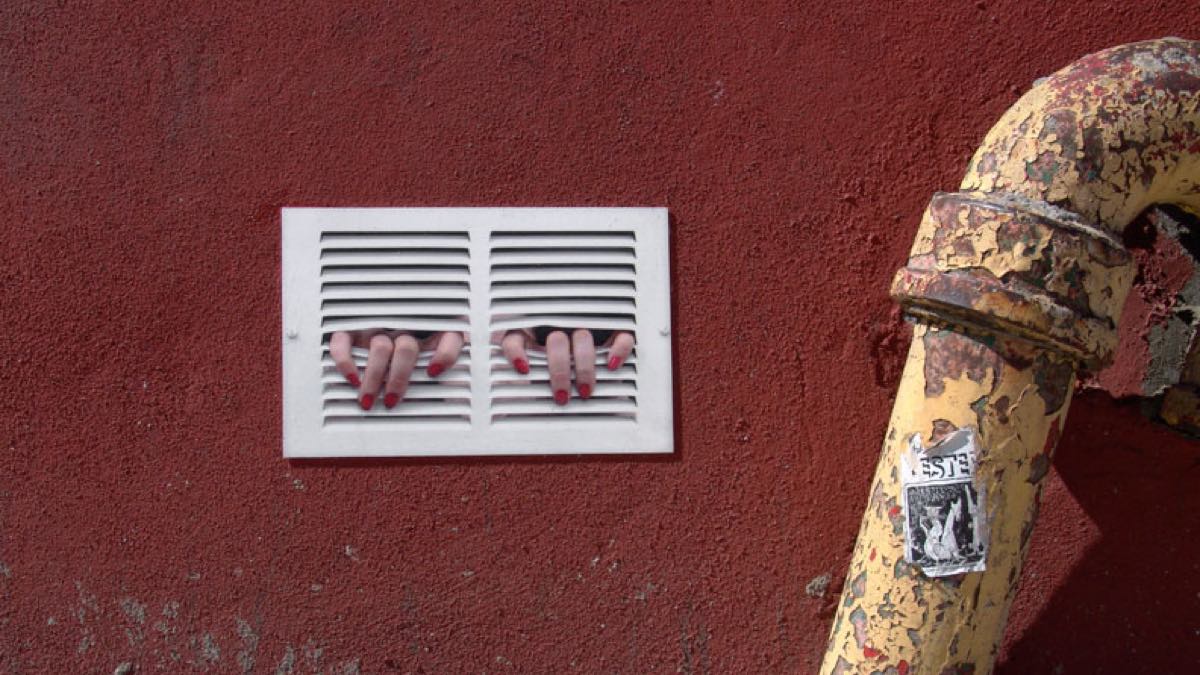
Optical illusions in Street Art
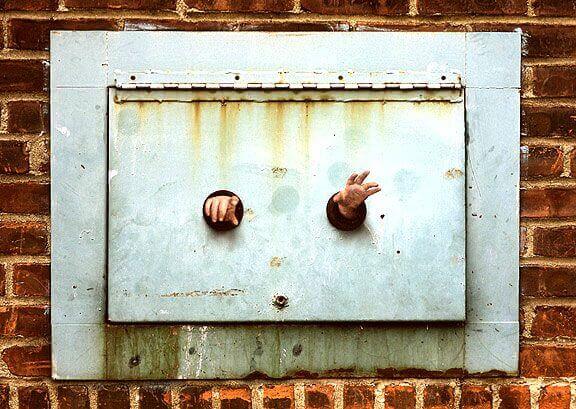
Artists have always been interested in optical illusions and visual tricks. From Arcimboldo’s portraits made out of fruits and vegetables to Salvador Dali’s double images and Holbein’s famous anamorphosis, optical illusions are a source of fascination in art.
Trompe-l’œil is a genre that draws on the visual confusion of spectators: you might know that you’re standing in front of a flat surface, but your eyes still perceive a three-dimensional image. Both deceptive and enticing at the same time, trompe-l’œil is not limited to canvases, but extends to walls too. These murals can be breathtaking. The standard effect of trompe-l’œil is the illusion that a flat object is three-dimensional, or the impression that a painting is jumping out of its frame, which therefore makes us question our perception of reality.
Today, quite a lot of street artists use this old technique to play with our understanding of the world and to integrate their work in the urban landscape in a striking way.
Artsper has selected 8 murals and artists who have mastered the art of the optical illusion, who can engage spectators in a complex dialogue with their environment.
1. Ernest Pignon Ernest

The real name of this artist is simply Ernest Pignon, whilst his alias is Ernest Pignon Ernest, and he was born in 1942 in the city of Nice. He is one of the pioneers of street art in France. Since 1966, he has travelled all over France and the world to put his ephemeral paper works on city walls to recall the too often forgotten stories of different places.
For each series, he digs into the past of the places he visits. He then chooses a significant episode or a period of time that he interprets his own way and exhibits in the streets.
From 1988 to 1995, he worked in the city of Naples, where layers of history all overlap – Greek, Roman, Christian. It’s a city whose origins inspired this artist to pay an homage to Caravaggio.
2. Dan Witz

This artist is from Chicago, and he started doing street art in New York at the beginning of the 1980s. Dan Witz is often called the “godfather of street” and is today internationally famous, especially for his humorous works on road signs.
His approach is both classic and modern: for him, figurative art is a starting point and a springboard to more expressive and less literal artistic approaches. He uses new technologies and old master technics in his work to reach more realism. Light, for example, is essential in his work.
In 2008, he started a series of optical illusions representing people behind grids. He place them in unexpected places of New York and other American cities. These pieces are strikingly realistic, and raise the question of imprisonment in both a literal and metaphorical sense.
3. Anders Gjennestad, alias STRØK
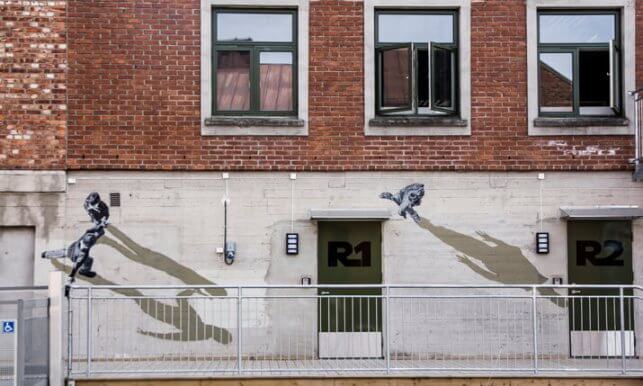
A Norwegian artist newly arrived on the street art scene, Anders Gjennstad, alias STRØK, is walking in the footsteps of the best stencil artists. He uses his own photographs as a reference for his work and creates multi-layered stencils to reach a photo-realist effect.
His work draws on the perception of space through perspectives and shadows: STRØK’s work make the viewer lose their spatial reference points and moves our center of gravity. The viewer suddenly finds themself in a moving setting, where up can become down at any moment.
4. Mike Hewson

This artist is from New Zealand, and he created a series of monumental murals in Christchurch – his hometown – for the project “Homage to the Lost Spaces”: the city had been partially destroyed during an earthquake in 2011.
Mike Hewson’s hyperrealist and ephemeral artworks were scattered on different places of the town. They payed a last homage to the story of those ruined buildings and gave them their life back for a moment. The aim was to show the buildings in their past functional state, before the catastrophe. Mike Hewson’s murals were only placed on buildings about to be demolished; they were like a last goodbye to those places.
5. Eduardo Relero

Eduardo Relero is an Argentinian artist who specializes in surrealist optical illusions which are made on the floor with chalk. Made for an audience, Relero’s work has travelled all over the world, from New York to Rome, Mexico and Tokyo.
When he started putting his works out in the street, he did not know anything about street art culture. Anamorphosis is his favorite artistic device: it is a distorted projection or perspective requiring the viewer to use special devices or occupy a specific vantage point to see the image in the way it is intended. Therefore, the viewer themselves has to actively decifer the image.
6. Juandres Vera
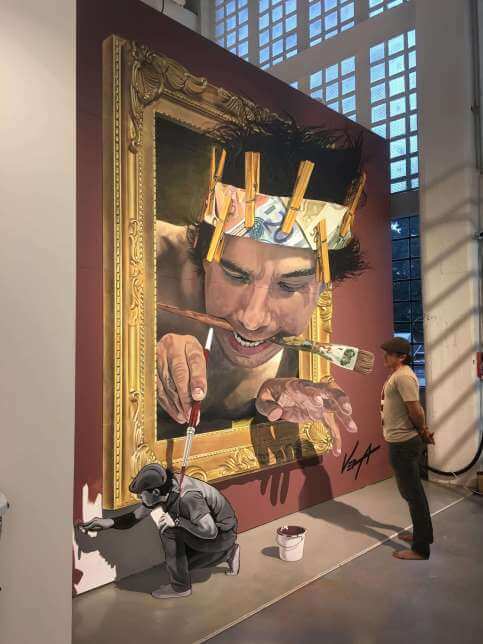
A Mexican street artist, Juandres Vera is known for his hyperrealist work all over the world, from Italy to the Netherlands, Thailand, Britain and the United States.
After having worked several years as a decorative painter, he turned to fine art and started in 2007 to do temporary urban installations. His art is strongly influenced by baroque painting as well as the surrealist style.
7. Zilda
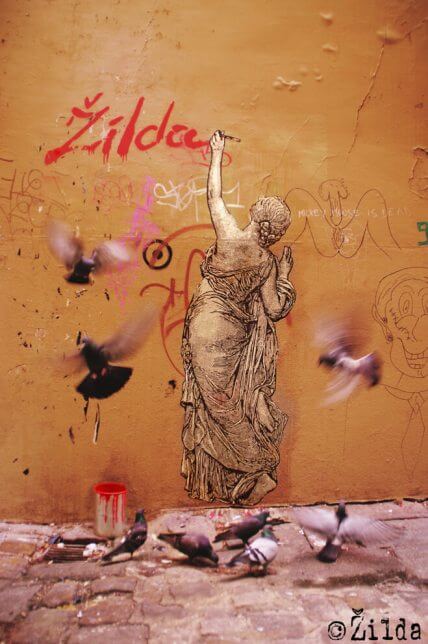
Zilda is a self-taught French artist from Rennes who first works on paper in his workshop before installing his pieces in the streets of Naples, Paris, Lorient and more. His work strongly recalls Ernest Pignon Ernest’s, whom he openly refers to as his primary source of inspiration, whether for his technique or the themes in his works: like his inspiration, Zilda reinterprets figures in the public consciousness, mythological and literary characters often with humor.
In Zilda’s work, everything is about where the piece is located and the dialogue it creates with the environment. Zilda’s carefully chosen locations reveal the poetic aspect of his work.
8. Cayetano Ferrer



An American artist who works with photography, videos, and sculptures, Cayetano Ferrer creates optical illusions based on transparency. Since 2004, in his series entitled “City of Chicago” and “Western Imports”, Cayetano Ferrer makes objects like cardboard boxes and road signs disappear in urban landscapes.
The artist starts by taking a picture of the chosen place and then reproduces the setting on a sticker that he then puts on the object, taking its volume into account. The object becomes almost invisible and disappears into its background, but never quite enough for the viewer to be unable to perceive its presence.

About Artsper
Founded in 2013, Artsper is an online marketplace for contemporary art. Partnering with 1,800 professional art galleries around the world, it makes discovering and acquiring art accessible to all.
Learn more













